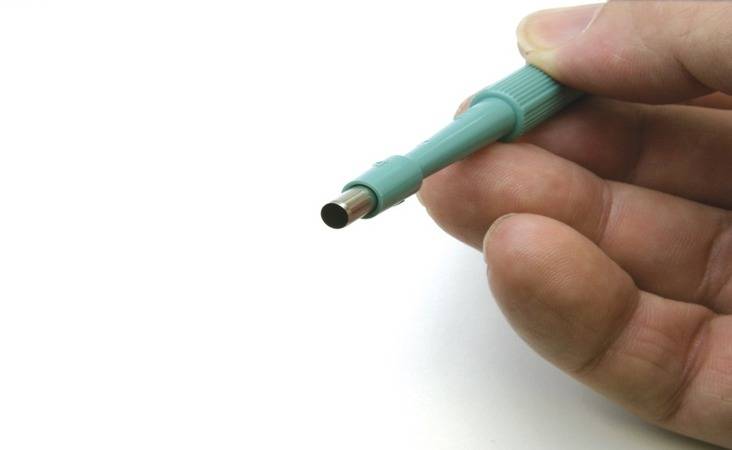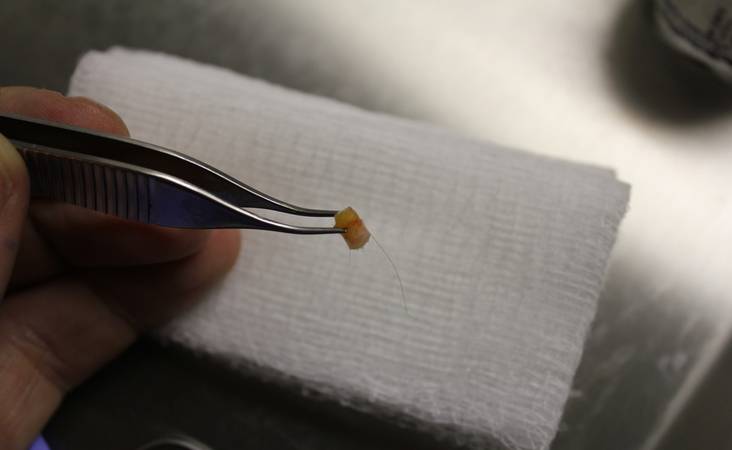Scalp Biopsy for Hair Loss: Everything Answered
- Written by Leo Lordhair
- Nov 19, 2021
- |
- 8 min read
 Listen to the full text
Listen to the full textThere are many methods to check and determine the root cause of hair loss among men and women, and a scalp biopsy is one of them. Having emerged as a promising tool in the past few years, a lot of dermatologists use it as part of the hair loss diagnosis and treatment process.
While there is no inadequacy of information promoting the use of scalp biopsy for hair loss, there is a lot, especially to new users, that is still unclear. This includes:
- How is a scalp biopsy performed?
- What are the different types of scalp biopsy?
- Are scalp biopsies really safe?
In this blog, Lordhair - the leading hair toupee supplier - will address all such questions about using scalp biopsies for hair loss. Let’s start unravelling the mystery of scalp biopsy by understanding its concept first!
What is a scalp biopsy?
A scalp biopsy is a process of removing cochlear, better known as hair cells or hair tissues, from the scalp which are used to assess clinically an individual’s hair condition. The removed hair cells and tissues are sent to the laboratory to be analyzed by dermatologists and trichologists.
Scalp biopsy also serves as a measure of hair loss diagnosis. It can be used to tell if there is any chance of hair recovery or re-growth. It can further be utilized to tell if there is any inflammation that can be treated to slow down the progression of hair and scalp disorders.

Types of scalp biopsy for hair loss
There are various types of scalp biopsy procedures for hair loss. The most common ones are:
- Shave biopsy: A shave biopsy is a biopsy technique used to remove a thin layer of skin from the affected areas together with skin abnormality on the scalp. As the name suggests, it is done by using a blade. But unlike ordinary hair shaving tools like razors with cartridges, shave biopsy involves the use of a small blade, for examination under a microscope.
- Punch biopsy: One of the most well-known biopsy procedures for hair loss. During the punch biopsy, a doctor uses a sharp, hollow, circular instrument called a punch to remove a small round piece of hair or skin tissue through all layers of the lesion.
- Excisional biopsy: Also called wide local excision (WLE), excisional biopsy is a procedure to remove a small area of disease-ridden or problematic hair tissue with a margin of normal tissue from the scalp. Although it is used in breast cancer patients to remove cancer and the immediate area of surrounding breast tissue, it can also be performed to discover the cause of hair loss.
A scalp biopsy isn’t the only solution for hair loss. Check out 15 ways to fix a receding hairline.
How is a scalp biopsy performed?
The following are the steps involved in performing a biopsy in order to learn and treat temporary or permanent hair loss conditions:
- The dermatologist spends a few minutes looking for the perfect spot to perform a scalp biopsy. If the individual has scarring alopecia, such as lichen planopilaris, they will look for an area with perifollicular erythema. They might look for empty tracts or vellus-like strands in case of non-scarring alopecia like alopecia areata.
- After figuring out the perfect spot, they outline the area using a marker pen.
- The hair is clipped to a distance of about 2-3 mm above the scalp that needs to be extracted. This helps the dermatologist to see the angle of hair emerging from the head accurately.
- The marked area is then cleaned using cleansing solutions like chlorhexidine.
- The skin surrounding the hair is also iced with a scalp-friendly numbing solution and left for 10-15 minutes. This allows the solution to take full effect.
- After 10-15 minutes, the dermatologist places a biopsy tool directly over the top of the hair and rotates it back and forth rapidly until the metal blade is entirely engulfed in the layer of subcutaneous fat.
- Once the biopsy site for hair loss has been made, it gets pulled up cautiously using the anaesthetic needle. The base is then removed from the scalp and placed into buffered formalin.

Dermatologists suggest biopsy sites be left uncovered. Although a bandage or dressing is not needed, men and women can apply petroleum jelly or antibiotic ointment over the incision site to keep it moist.
Cost of a scalp biopsy
Unlike skin biopsy procedures, the cost of a scalp biopsy for hair loss is pretty high. That’s because a specialist scalp condition pathologist conducts the procedure. The type of biopsy is another factor. The cost of scalp biopsies for identifying and treating hair loss in men and women can easily go above US$800.
Discover a premium collection of non-surgical hair replacement systems
Risks associated with scalp biopsies
All the greatest treatments and procedures in the medical world come with their share of side effects and risks. Meaning, liabilities are also associated with scalp biopsy. The most common risks coupled with this medical procedure for hair loss are as follows:
Preoperative risks
- Anaesthesia
- Anaphylaxis
- Vasovagal attack
Intraoperative risks
- Pain
- Discomfort
- Bleeding
- Temporary numbness
- Weakness
Postoperative risks
- Swelling
- Tenderness
- Scarring
- Hyperpigmentation

Best scalp biopsy alternative for hair loss
There is no shortage of treatments and procedures that help men and women deal with hair loss. If your hair loss is extreme, then, the best biopsy alternative is wearing a hair replacement system.
Also known as a modern-day wig, a hair system is designed using real human hair hand-woven onto a base made of premium skin-friendly materials.
Unlike a scalp biopsy, a hair system (also known as hairpieces for men) is a non-surgical solution to hair loss that carries no side effects. Attached using clips, tape, or glue, it blends easily with real hair and helps deliver a natural look.
Benefits of hair systems
A hair replacement system comes with many benefits. Here are some of them:
- Delivers quick results
- Can be attached swiftly
- Highly cost-effective: a year’s supply of hair systems can cost less than US$1000
- Semi-permanent with regard to attachment: meaning you don't take it off every day
- Comfortable, breathable, and durable
Check out this hair transformation powered by a hair system:
Final words on scalp biopsies
Everything that you need to know about scalp biopsies for hair loss is in front of your eyes. As the motive of using this procedure is to determine the source of your hair loss, it is undeniably worth considering during the initial stage of diagnosis.
However, it can’t treat the cause of your hair loss. For that, you have to consult your dermatologist. You can also buy and wear a hair system for the time being.
Just make sure to buy it from a trusted supplier like Lordhair and you will get the promise of a premium hair recovery product that comes with a money-back warranty.
Got any queries to ask? Send them to support@lordhair.com and have them answered by our hair experts.
Read our recent blogs for hair wisdom and hacks:
A quick guide to deal with hair loss during periods
Unprocessed human hair wigs to buy in 2022
Everything about dermarolling for hair loss


